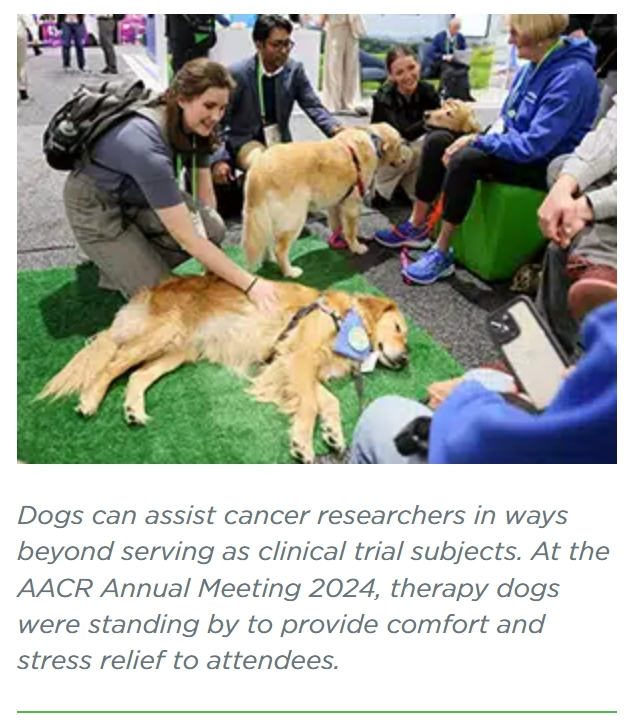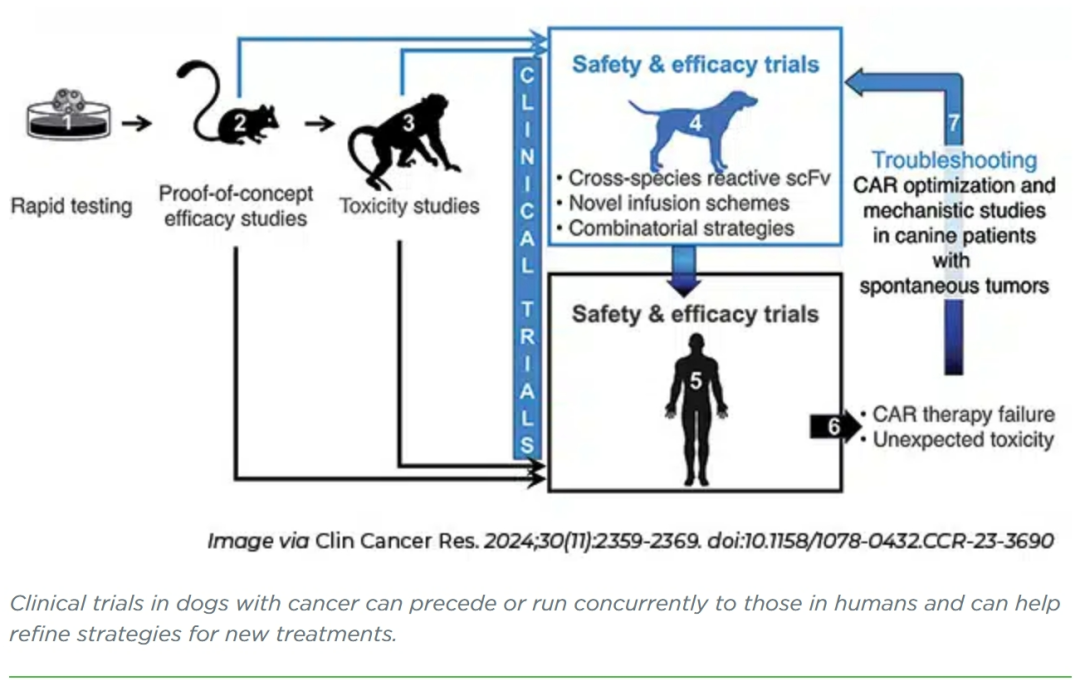
以下内容原文发布于AACR官方博客《Cancer Research Catalyst》, 中文内容仅做参考,请点击文末“阅读原文”,阅览原文内容。
对许多人来说,宠物是他们珍视的家庭一员,而宠物罹患癌症的消息对他们而言无疑是一个沉重的打击。不幸的是,狗被诊断出癌症的比例大约是它们主人的五倍; 4 月 5 日至 4 月 10 日在圣迭戈举行的 2024 年美国癌症研究协会( AACR )年会上公布的一项数据显示,在美国,人类癌症的年发病率约为每 10 万人 500 例,而犬类则高达每 10 万只 2500 例。
对人类癌症患者而言,即使在用尽了所有可能的治疗方法之后,他们通常还可以参加临床试验以尝试实验性治疗方案,从而有更多的机会战胜癌症或将癌症控制更长时间。那么对罹患癌症的狗来说,情况又如何呢?
目前已有许多大型兽医研究机构提供针对狗的临床试验(相关临床试验指标由美国兽医协会和美国养犬俱乐部等组织维护),而这些试验的结果有时甚至能为治疗人类癌症的新方法提供参考。
在2024年AACR年会的犬类癌症研究专题会议上,宾夕法尼亚大学兽医学院博士Nicola
Mason(BVetMed、PhD)表示,患癌症的狗是研究癌症生物学和评估新疗法的理想模型系统。与人类一样,狗也会随着年龄的增长而自发性罹患肿瘤。狗的免疫系统也与人类相似,两个物种都有类似的癌症驱动基因。此外,伴侣犬的生活方式和环境与人类有诸多相似之处,可以揭示一些由环境暴露因素所导致的癌症。
在犬类中开展癌症研究能否拯救我们四条腿朋友的生命?又能否为人类癌症提供有价值的信息?最近的研究通过展示新工具、新方法以及一些成功案例向我们揭示了上述可能性。
了解更多内容,请阅读以下原文。
Old Dogs Can Teach Cancer Researchers New Tricks
Pets are treasured members of many families, and news that they have developed cancer can hit hard. Sadly, dogs receive a cancer diagnosis at about five times the rate of their owners; in the United States, the annual incidence of cancer is around 500 cases per 100,000 people but 2,500 cases per 100,000 dogs, according to data presented at the American Association for Cancer Resea rch (AACR) Annual Meeting 2024 , held April 5-10 in San Diego.
When humans with cancer have exhausted all available therapeutic options, they can often enroll in clinical trials to try experimental treatments, giving them an additional chance to beat their cancer or hold it at bay longer. What about dogs with cancer?
Not only are clinical trials for dogs offered at many major veterinary research institutions—with clinical trial indices maintained by organizations such as the American Veterinary Medical Association and the American Kennel Club—but the results from those trials can sometimes inform new approaches for treating cancer in humans.
Dogs with cancer represent an ideal model system for studying cancer biology and assessing new treatments, explained Nicola Mason, BVetMed, PhD, of the University of Pennsylvania School of Veterinary Medicine, in a session about canine cancer research at the AACR Annual Meeting 2024. Like humans, dogs can spontaneously develop tumors as they age. Dogs also have a similar immune system to humans, with analogous cancer driver genes in both species. Further, companion dogs share many components of humans’ lifestyle and environment, which can shed light on exposure-driven cancers.
Can conducting cancer research in dogs save the lives of our four-legged friends while also providing valuable insights into human cancers? Recent research has provided new tools, approaches, and success stories that hint at the possibilities.
Hounding the Data: What Dogs With Cancer Tell Us About Humans With Cancer
The use of companion dogs as animal models is a type of comparative oncology—the study of naturally occurring cancers in animals to inform human cancer biology. In 2003, the National Cancer Institute (NCI) of the National Institutes of Health established the Comparative Oncology Program to create a centralized hub for managing and sharing data gleaned from studying cancer in pets, primarily in cats and dogs.

The Comparative Oncology Program provides support in the design, implementation, and management of cancer clinical trials in companion animals. Through this program, the NCI has also launched a centralized data repository—the Integrated Canine Data Commons (ICDC)—as part of its Cancer Research Data Commons hub. The ICDC houses a variety of clinical, genomic, transcriptomic, and methylation data from clinical trials performed in dogs with cancer to help researchers explore hypotheses and make comparisons.
In addition to the ICDC, there are several other tools available for comparative canine research, explained Cheryl London, DVM, PhD, of the Cummings School of Veterinary Medicine at Tufts University, during the Annual Meeting. A newer canine reference genome published in 2021 closed several gaps that had previously hindered comparative studies, London said. Networks such as the Clinical and Translational Science Award One Health Alliance and the PRE-medical Cancer Immunotherapy Network for Canine Tumors (PRECINCT) are working to bring together veterinary researchers and clinician scientists for unique collaborations that further therapeutic advances in both species.
London and colleagues have used such tools to study the commonalities between canine and human cases of osteosarcoma, an aggressive type of bone cancer. While osteosarcoma is rare in humans, it is relatively common in dogs, providing a large sample size to study tumor characteristics and test potential therapies. Research has shown that osteosarcoma has a similar pattern of disease progression in both species, with metastases often displaying resistance to chemotherapy and signaling an especially poor prognosis. Further, dog and human osteosarcomas have similar genetic driver mutations and, importantly for London’s work, similar immune microenvironments. This includes the presence of immune-suppressive myeloid cells that London and colleagues are working to therapeutically target.
Other researchers, including Karin Allenspach, DMV, PhD , from the College of Veterinary Medicine at the University of Georgia, are exploring how we can use canine-derived cell and organoid models to study rare subtypes of bladder cancer . Sarcomatoid urothelial carcinoma (SUC) comprises less than 1% of bladder cancer cases in humans, and it is often aggressive and diagnosed at a late stage. Like osteosarcoma, SUC appears to be more common in dogs, Allenspach explained during the AACR Special Conference in Cancer Research: Bladder Cancer: Transforming the Field .
Allenspach and colleagues have built a robust archive of tumor biopsies, organoid lines, and histology slides of canine muscle-invasive bladder cancer. Allenspach hopes that such a library can enable further research into rare bladder cancer variants, including the testing and development of new treatments. As a proof of concept, her group has characterized the gene expression of organoids derived from canine SUC and found an upregulation of genes involved in the epithelial-to-mesenchymal transition (EMT) compared to other bladder cancer subtypes.
But can dogs with cancer help us figure out why we get cancer in the first place? Evolutionarily, yes, argued Jaime Modiano, VMD, PhD , of the University of Minnesota Masonic Cancer Center and College of Veterinary Medicine, during the Annual Meeting.
Humans have doubled their lifespan since the Industrial Revolution—a miniscule amount of time in evolutionary terms—and we’ve extended the lives of our canine and feline companions in kind. As we are beating aging-related diseases artificially, our genomes are having trouble keeping up, noted Modiano.
Not coincidentally, dogs and cats are the only other animals that develop cancer at rates comparable to humans. Modiano explained that we can use dogs to study approaches to mitigate the accumulation of cancer-driving damage that evolution hasn’t solved yet, something he and his colleagues are working on.
“Living longer than nature intended accounts for a substantial component of the risk of cancer that we see in companion dogs, and probably in cats, and likely in humans,” he said. “If we can … mitigate that risk, we can potentially decrease the impact of cancer in our society.”
Putting Cancer in the Doghouse: Testing New Immunotherapies in Canines
In addition to new insights about how tumors behave, dogs with cancer can also provide a valuable mechanism for testing new treatments. In recent years, researchers have especially utilized canine clinical trials to test new immunotherapies.
Testing treatments in mice with intact immune systems introduces several extra hurdles to the research process, whereas immune cells naturally interact with tumors in the same way in both dogs and humans. In a review published in the AACR journal Clinical Cancer Research, veterinary scientists Jeffrey Bryan, DVM, PhD, and Charles Maitz, DVM, PhD, from the University of Missouri Ellis Fischel Cancer Center, explored how research in canines is helping to solve some key immunotherapy quandaries in humans.
Cancer vaccines are one example. Most progress on cancer vaccines in humans has focused on autologous vaccines, in which each patient’s tumor is analyzed to identify their own personalized mixture of immunogenic peptide sequences. An allogenic vaccine that could treat multiple patients could make the process more efficient and accessible. In one allogeneic vaccine study, researchers engineered a dog melanoma cell line to express the human protein gp100 then injected the cells into canine patients to better train the dogs’ immune systems to fight melanoma; the disease control rate was 35.3%. Other researchers are testing whether a Listeria bacterium engineered to express HER2 can help fight canine osteosarcoma.

Because it may be harder to test such innovative methods in humans, canine clinical trials provide an ideal middle ground for ambitious treatment paradigms and trial designs. London and colleagues conducted a drug screening trial in canine osteosarcoma to test combinations that might turn off immune-suppressive signaling from tumor-associated macrophages. They initially tested the combinations in cohorts of five dogs apiece, and one combination—toceranib, losartan, and ladarixin—performed well enough to garner an expansion cohort that experienced a clinical benefit rate of 70%. The researchers then tested this regimen in dogs before surgery with promising results.
“The neoadjuvant study that we did would have never been possible on the human side,” London said. “It allowed us to do something really innovative that’s hard to do [in humans].”
Antonia Rotolo, MD, PhD, and Matthew J. Atherton, PhD, of the University of Pennsylvania School of Veterinary Medicine, echoed this sentiment in relation to the production of cellular immunotherapies, such as CAR T therapy, for dogs and humans. “Because of less stringent regulatory barriers, dogs provide a more accessible setting for testing non-conventional cellular platforms, donor sources, and combinatorial approaches compared with humans,” they wrote in a review article published in Clinical Cancer Research.
In the article, Rotolo and Atherton outlined several ways in which canine clinical trials are testing new paradigms in CAR T therapy. As with vaccines, CAR T therapy could benefit from allogeneic, off-the-shelf products, but allogeneic cells have sparked safety concerns in human patients. Researchers are currently studying the use of CAR T cells from healthy donor dogs—and even from humans—in canine lymphoma patients. Researchers are also evaluating the safety of CAR-edited natural killer cells in dogs, as well as various doses, routes of administration, and infusion schedules for CAR T cells targeted toward solid tumors.
Mason discussed a few of the solid tumor targets, including HER2 and B7-H3, for which researchers are using canine clinical trials to optimize therapies. Both proteins are also expressed in healthy tissues, making toxicity a significant concern. Dogs’ robust immune systems and comparable tumor characteristics present an ideal model to test new CAR T-cell design and administration paradigms to mitigate side effects.
Mason also pointed out that dogs, like humans, experience cytokine release syndrome, a hyperactive immune response that forms a relatively common side effect of CAR T therapy. Testing new CAR T regimens in dogs with cancer may help researchers anticipate—and learn to mitigate—the syndrome in humans.
“The dogs do represent a clinically relevant—and importantly immune competent—preclinical model for adoptive cell therapies that will help us advance those in the human field,” Mason said.
更多内容,请点击“阅读原文”
排版编辑:肿瘤资讯-Astrid











 苏公网安备32059002004080号
苏公网安备32059002004080号


